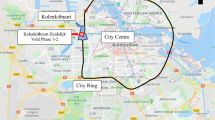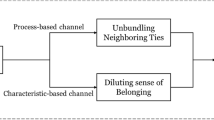Abstract
This paper deals with the behavioral pattern of neighbor relations and their relationships to the subjective attitudes and expectations of the residents. The sample was 318 middle-class women living in eight-to 20-story buildings. The findings indicate that respondents so desiring were able to develop active social ties with their neighbors. Moreover, they interacted with neighbors despite the fact that the majority had opportunities for alternative social relations. The distinction between “localized” and “nonlocalized” high-rise residents does not seem meaningful in this case. Actual social ties with neighbors were related to norms and expectations regarding neighbor relations. Despite active neighboring, respondents did not have difficulties obtaining privacy.
Similar content being viewed by others
References
Altman, I. (1975).The Environment and Social Behavior. Brooks/Cole, Monterey, California.
Ash, J. (1980). The rise and fall of high-rise housing in England. In Ungerson, C., and Karn, V.The Consumer Experience in Housing. Gower, London, pp. 92–123.
Fischer, C. S. (1982).To Dwell among Friends: Personal Networks in Town and City. University of Chicago Press, Chicago.
Fischer, C. S., Jackson, R. M., Stueve, C. A., Gerson, K., and Jones, L. M. (1977).Network and Places: Social Relations in the Urban Setting. Free Press, New York.
Frank, K. A. (1980). Friends and Strangers: The social experience of living in urban and nonurban settings.The Journal of Social Issues 36/3 (Summer): 32–71.
Gans, H. J. (1962).The Urban Villagers. Free Press, New York.
Gans, H. J. (1968).People and Plans. Basic Books, New York.
Greer, S. (1962).The Emerging City. Free Press, New York.
Jephcott, P. (1971).Homes in High Flats. Oliver and Boyd, Edinburgh.
Keller, S. (1968).The Urban Neighborhood. Random House, New York.
Mackintosh, E., Olsen, R., and Wentworth, W. (1977). The middle income family's experience in an urban high-rise complex and the suburban single family home. City University Graduate Center, New York.
Marcus, C., and Hogue, L. (1976). Design guidelines for high-rise housing.Journal of Architectural Research 5: 34–39.
McCarthy, D., and Saegert, S. (1978). Residential density, social overload and social withdrawal.Human Ecology 6/3: 253–272.
McGahan, P. (1972). The neighbor role and neighboring in a highly urban area.Sociological Quarterly 13: 397–408.
Michelson, W. (1977).Environmental Choice, Human Behavior and Residential Satisfaction. Oxford University Press, New York.
Rossi, P., and Shlay, A. B. (1982). Residential mobility and public policy issues: “Why families move” revisited,The Journal of Social Issues 38/3: 21–34.
Stevenson, A. (1967).High Living: A Study of Family Life in Flats. Melbourne University Press, Melbourne.
Weckerle, G. (1977). Residential choice and housing satisfaction in a singles high-rise complex. In Conway, D. J. (ed.).Human Response to Tall Buildings. Dowden, Hutchinson and Ross, Stroudsburg, Pennsylvania, pp. 230–239.
Welhnan, B. (1979). The community question: The intimate networks of East Yorkers.American Journal of Sociology 84/5: 1201–1231.
Williamson, R. C. (1981). Adjustments to the high-rise: Variables in a German sample,Environment and Behavior 13/3 (May): 289–310.
Yancey, W. L. (1971). Architecture interaction and social control: The case of a large-scale public housing project.Environment an Behavior 3/1 (March): 3–21.
Young, M., and Willmott, P. (1962).Family and Kinship in East London. Penguin, London.
Zito, J. M. (1974). “Anonymity and neighboring in an urban, high-rise complex.Urban Life and Culture 3/3 (October): 243–263.
Author information
Authors and Affiliations
Rights and permissions
About this article
Cite this article
Ginsberg, Y., Churchman, A. The pattern and meaning of neighbor relations in high-rise housing in Israel. Hum Ecol 13, 467–484 (1985). https://doi.org/10.1007/BF01531155
Issue Date:
DOI: https://doi.org/10.1007/BF01531155




